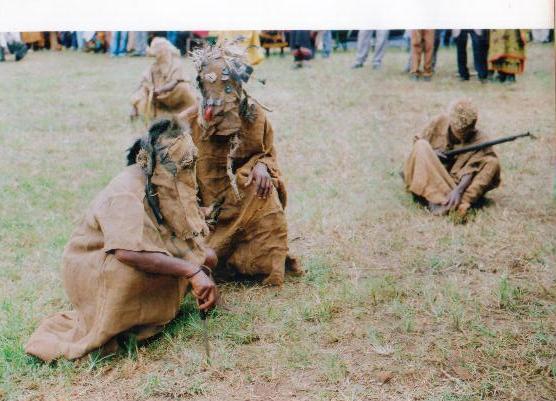HIS ROYAL MAJESTY THE FON OF AWING
"Our adoration for peace and respect for State institutions has spared us from enemies who think that they can stop us from constructing Awing.
Awing people, we will not stop on the way. You have proven your maturity and loyalty to our time-honored institutions and the king that I am who incarnates them. I know we have detractors but we must keep advancing. We have to move on Awing people, because we have an account to render to posterity."
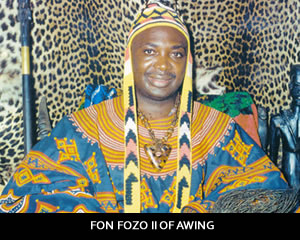
The Fon, our leader
A blend of traditional and modern centralized administration is applied by the Fon who is at the apex of the administrative ladder. The Fon’s palace “Nto’o” is the melting pot of decision making and seat of traditional institutions. The powers of the decision of the Fon are spiritually re-inforced by a venerated council that constitutes the most dreaded and weird secret society called “Kwifo’o” is the regulator of the fondom governing machinery. All activities that are carried out by whosoever in variance with the decree of the Kwifo’o tantamount to incalculable risk.
It was during the reign of Alo'ndzafo'o II that Awing people moved from Alameti and settled in Babajou. Akofo'o the next Fon was killed during a skirmish between Babajou and their neighbours Penyin.Akofo'o children wer It was during the reign of Alo'ndzafo'o II that Awing people moved from Alameti and settled in Babajou. Akofo'o the next Fon was killed during a skirmish between Babajou and their neighbours Penyin.Akofo'o children wer It was during the reign of Alo'ndzafo'o II that Awing people moved from Alameti and settled in Babajou. Akofo'o the next Fon was killed during a skirmish between Babajou and their neighbours Penyin.Akofo'o children wer It was during the reign of Alo'ndzafo'o II that Awing people moved from Alameti and settled in Babajou. Akofo'o the next Fon was killed during a skirmish between Babajou and their neighbours Penyin.Akofo'o children wer It was during the reign of Alo'ndzafo'o II that Awing people moved from Alameti and settled in Babajou. Akofo'o the next Fon was killed during a skirmish between Babajou and their neighbours Penyin.
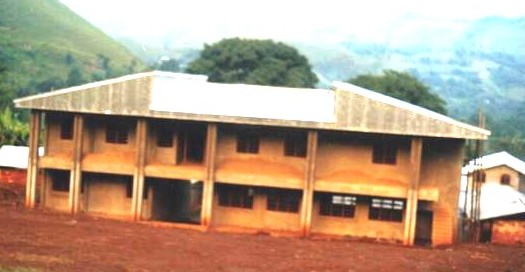
In 1949, during the rein of Fon Ayafor, fire consumed the numerous thatch structures that made up the Awing Fon`s Palace at the time.
Mobilization was total and various quarters faced the challenge and within a few weeks reconstructed a new palace which was inherited by Fon Ngongeh III in 1950 following the disappearance of his father Fon Ayafor from the palace.Fon Ngongeh III during his forty eight years on the throne, increased and improved on the palace structures until his disappearance in 1998.
Before his disappearance from the palace, a son of Awing had remarked and wisely too that " A man`s best residence should be in his village and that the best house in the village ought to be the Fon`s Palace" Ntumfor Nico Halle.
This is how the Awing Fon’s Palace project was initiated and coordinated by this illustrious son of Awing. The rest is history.
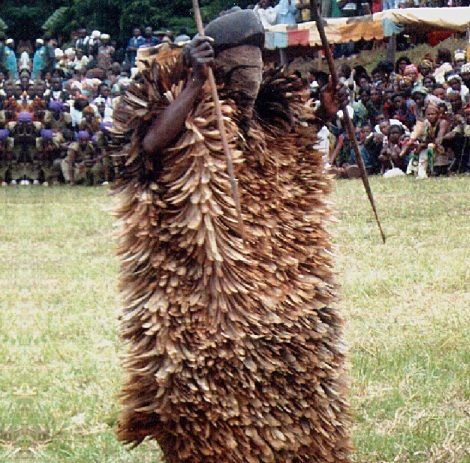
Kwifo’o, the law makers
Kwifo’o issues injunctions against hunting in specific areas, bush burning, constructing in places reserved for farming and some development projects, tapping in certain palm grooves. 30 elected people of high social status constitute the village parliament. They make laws that are binding on the community via four communities; land dispute, farmer grazier, health and social affairs and stimulate all communal resources for community work.
Quarter heads are part of the administration with assigned tasks. They oversee peace and order within their areas of command. The Fon is the auxiliary and representative of the administration and is remunerated by the state. He transmits the demand and aspirations of the subjects to the government. The current political pluralist dispensation breeds open competition by political parties in Awing. The daily management of palace is spiced with some elements of modern administration. The internal affairs of the palace are carried out by a director of cabinet in the person of Mbafor while Mofor Ntsinde is in charge of the management of the day to day affairs of the palace.
AWING ROYAL GENERATION
- Mefumetu (Nkachi)
- Mefumenegome
- Ngongeh I
- Alo’ndzafo’o I
- Nkeunjie
- Ngongeh II
- Nkefo’o
- Alo’ndzafo’o II (1825-1858)
- Akofo’o (1858-1870)
Regency (1870-1879)
- Fozo’o I (1879-1911)
- Ayafo’o I (1911-1949)
- Ngongeh III (From 5th Jan. 1950 to 23rd April 1998)
- Fozo’o II (4TH May 1998)
It was during the reign of Alo'ndzafo'o II that Awing people moved from Alameti and settled in Babajou. Akofo'o the next Fon was killed during a skirmish between Babajou and their neighbours Penyin.
Akofo'o children were too young to ascend to the throne; hence the regency period of nine years which only ended when Atefor, the brother of Akofor, was crowned Fon Fo'ozo I.
The throne of Awing was vacant for nine years during this period of regency with Ta Temengye and associates acting as regents
THE 9 ORIGINAL CLAN HEAD OF AWING KINDOM
These forefathers of Awing play the important function of “pekem pe ngong”. They are:
Ndime
Mbangwashi
Mba’ala
Mbantse
Tangye Mona
Mbankadmbi
Mbanjua
Mbatia
Mbamome
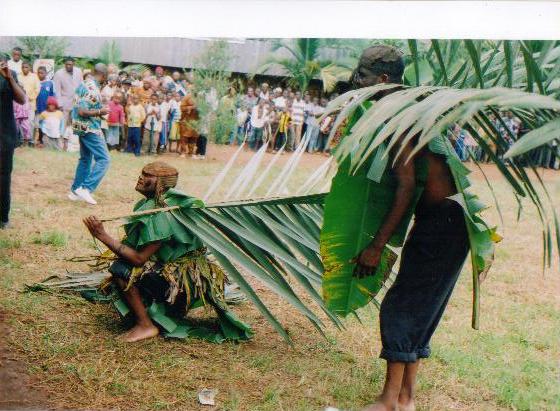 Police of the Fondom
Police of the Fondom
Maintaining internal security within the fondom is one of the most daunting tasks of the traditional authority. The mission is shared by institutions like, Kwifo’o Me’nji, Mopo’o, Nekang, Afuobangifo’o, Lale’e and uanipo’o.
Nekang and Mopo’o are o the same cult but play different roles, while the former is the ombudsman that checks the excesses of the leadership of the fondom; the later is there to physically protect the Fon and his institutions. Their appearance in public is always marked by sombreness and no one dare sneezes nor accepts an offer especially from Nekang. Even the lampooned Fon does not have a say.
Me’nji the backward moving magic party seldom appears in public. It is being said, children born some twenty years ago have never witnessed it. However, its institution is being sharpened always.
Nevertheless these traditional forces of the land have been strengthened by the government through the creation of a Gendarmerie Brigade.
Mopo’o is the valiant officer of the Fondom who ensures the peace and security of the Fon and Kwifo’o when they are attend and grace an occasion, like the death ceremony and other important occasions. Owing those functions is an armed officer. This armed officer uses essentially spears (Mekong) which he waves out skilfully to ensure peace, and tactically, when the occasion arises, to wage war in order to impose serenity and security.
